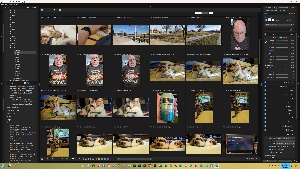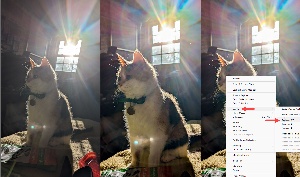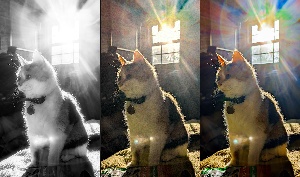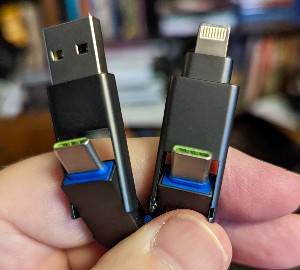Listen to the Podcast
8 Mar 2024 - Podcast #872 - (17:45)
It's Like NPR on the Web
If you find the information TechByter Worldwide provides useful or interesting, please consider a contribution.

If you find the information TechByter Worldwide provides useful or interesting, please consider a contribution.
Usually I don’t talk much about an application that hasn’t been updated for nearly three years, but I’m going to make an exception for Exposure X7. Alien Skin Software changed its name to Exposure several years ago and the most recent version of the company’s premiere application was released in 2021.
Although Exposure X7 lacks support for some newer cameras and formats and includes no AI functionality, it performs many tasks exceedingly well. It’s “film looks” that made Exposure famous. Those who remember the appearance of various film types, and I suppose that’s a smaller group every year, will appreciate Exposure’s ability to recreate the looks of Agfa, Ilford, Fuji, and Kodak films, black and white as well as color, negative and positive film stock. There are also settings for specialized films such as Kodalith, cinema film stock, Polaroid, and vintage color processes such as Autochrome.
Exposure functions as a plug-in for Lightroom Classic and Photoshop as it had for many years. But recent versions also run in standalone mode. Adobe Lightroom mimics a few of Alien Skin’s film look features. Perhaps in response to that, Alien Skin gave Exposure features for organizing photos somewhat like Lightroom, but without a catalog. And it continues to run it as a plug-in.
When I asked Exposure CEO Finley Lee what plans the company has, he said he doesn’t have any information to share about major updates, but Exposure is working on support for several new cameras and that users will “see notifications about those in the app when they’re ready to publish.” Support for new cameras is essential only for those who use Exposure in standalone mode. When used as a Lightroom Classic plug-in, Exposure will work with any file than Lightroom can open.
Regardless of Exposure’s future, the film-look technology is worth having and those functions are available to anyone, inside or outside Lightroom Classic. Exposure X7 can read information from files that have been modified by the Adobe product, but someone who has worked out specific workflows over the years with Adobe applications may prefer to keep those workflows while still using Exposure’s features.
Those who choose to run Exposure X7 as the primary photo organization and editing tool can send modifications made in Lightroom Classic to Exposure. There is no option to send an image from Exposure to Lightroom Classic, nor should there be.
When Exposure starts for the first time, it examines your computer. If the graphics processing unit (GPU) is adequate, most of the graphics processing can be off-loaded from the CPU for faster overall operation.
Used as a standalone application, Exposure has a lot of panels that hold tools designed for specific operations. These are arranged into four workspaces: Defaults (in which every tool is present), Culling, Editing, and Retouching.
Click any small image for a full-size view. To dismiss the larger image, press ESC or tap outside the image.
 Culling displays the smallest number of tools because during the culling phase, you’ll be examining images, comparing them, and deciding which ones you want to work with; but you won’t be doing any cropping, color correction, or styling. Then you’ll move on to the Editing workspace to make basic changes and then to the specialized Retouching workspace for final modifications. Tools and image displays can be distributed to secondary monitors.
Culling displays the smallest number of tools because during the culling phase, you’ll be examining images, comparing them, and deciding which ones you want to work with; but you won’t be doing any cropping, color correction, or styling. Then you’ll move on to the Editing workspace to make basic changes and then to the specialized Retouching workspace for final modifications. Tools and image displays can be distributed to secondary monitors.
Those who want specialized workspaces with a different selection or arrangement of tools can quickly create and name one.
Unlike Lightroom Classic, Exposure doesn’t create a catalog. This makes the process of switching between editing mode and image review mode as easy as pressing the Escape key during edits and double-clicking a thumbnail image to open it in edit mode. But it also means that Exposure must create sidecar files with information that is mostly not human readable except for information about the camera and lens used to create the image at the top of the sidecar file and Exchangeable Image File (EXIF) data at the end of the file. All of the information about edits applied to the image is unreadable by humans. Adobe’s catalog files are also not human readable, so this isn’t a disadvantage, but the sidecar files are saved in an Exposure Software directory below the directory that contains your images. It’s important, if you move an image to a new location on the disk drive that the sidecar file is moved, too. Sidecar files have the same name as the image and an ".exposurex7" extension.
 Those who use Lightroom Classic to organize photos will probably use Exposure X7 as a plug in most or all of the time, starting with basic operations such as straightening in Lightroom, possibly making some adjustments, and then passing the image to Exposure. The image I used shows Holly Cat, who is Chloe Cat’s successor, sitting on a bed with a strong backlight from the sun. This is just a basic JPG taken with a phone.
Those who use Lightroom Classic to organize photos will probably use Exposure X7 as a plug in most or all of the time, starting with basic operations such as straightening in Lightroom, possibly making some adjustments, and then passing the image to Exposure. The image I used shows Holly Cat, who is Chloe Cat’s successor, sitting on a bed with a strong backlight from the sun. This is just a basic JPG taken with a phone.
 What I like most about Exposure is its dozens of film looks, each of which serves as a starting point that can be extensively modified. I selected three samples for this report: a black-and-white treatment called Bright Fog and two color treatments, Autochrome and a cinema look called Technicolor 4. The Autochrome effect has a lot of grain because it’s a color process from 120 years ago. The Autochrome process was patented in 1903 by the Lumière brothers in France. It was first marketed in 1907. Autochrome used what’s called a mosaic screen plate process and was the primary method used for color photography until the mid-1930s. The Technicolor process dates to 1916. It used three cameras in the 1930s and that setup was used until the 1950s. Process 4 was the most widely used color process in Hollywood between 1939 and about 1960.
What I like most about Exposure is its dozens of film looks, each of which serves as a starting point that can be extensively modified. I selected three samples for this report: a black-and-white treatment called Bright Fog and two color treatments, Autochrome and a cinema look called Technicolor 4. The Autochrome effect has a lot of grain because it’s a color process from 120 years ago. The Autochrome process was patented in 1903 by the Lumière brothers in France. It was first marketed in 1907. Autochrome used what’s called a mosaic screen plate process and was the primary method used for color photography until the mid-1930s. The Technicolor process dates to 1916. It used three cameras in the 1930s and that setup was used until the 1950s. Process 4 was the most widely used color process in Hollywood between 1939 and about 1960.
Each of these images could have a mask applied to limit the effect to specific areas and dozens of settings can be modified. These range from basic exposure and contrast, color balance, and tint to more specialized modifications for sharpening, noise reduction, focus, grain, and more.
The most significant feature added in Exposure X7 is advanced masking. Masks allow the photographer to apply modifications to specific areas of images. Most photo editing programs offer circular (or radial) masks, linear masks, paint-on masks, and some form of automatic masking that’s based on a combination of color and brightness. Exposure’s polygon selection tool speeds masking by allowing photo editors to draw a rough border around the object. The software then detects the edges and creates its best-guess mask. The selection can be fine-tuned using any combination of other masking tools.
Whether used as a plug-in or standalone, Exposure X7 has a lot going for it even if it hasn’t received any major updates for a while. For more information, visit the Exposure website.
Manufacturers of hardware reviewed on TechByter Worldwide typically loan the hardware and it must be returned at the end of the review period. Developers of software reviewed on TechByter Worldwide generally provide a free not-for-resale (NFR) license so that all features of the application will be unlocked.
In July 2022, I wrote about the InCharge Mini and the InCharge X, which seemed like useful tools because they connected various devices easily. Two years later, I reiterate that recommendation.
Click any small image for a full-size view. To dismiss the larger image, press ESC or tap outside the image.
 Rolling Square is a Swiss company that designs products for manufacture in China. The resulting products are innovative. For example, a cable with two different connectors on each end. Since my initial report, the company has added more than a dozen useful devices.
Rolling Square is a Swiss company that designs products for manufacture in China. The resulting products are innovative. For example, a cable with two different connectors on each end. Since my initial report, the company has added more than a dozen useful devices.
But let’s talk about the InCharge X, which is intended for use with devices that are adjacent to each other because from end to end, including the connectors, the cable is just 5½ inches long. A larger Max version is 59 inches long and there’s an XL version that’s 10 feet long.
One end of the cable has a USB-A connector and a USB-C connector; the other end has a USB-C connector and a Micro USB connector, which Apple calls “Lightning”. Apple is phasing out Lightning connectors, but they are common in older phones. USB-C is common on desktop, notebook, and laptop computers, as well as tablets; and USB-A connectors are used by many current and legacy devices. So a single cable can connect USB-A to USB C, USB-A to Micro USB, USB-C to USB-C, and USB-C to Micro USB. The cables can be used for data or to power devices.
 My older daughter was at the house for some help with her Apple phone. Her Facebook account had been compromised to the point that we needed to create a new account, but there were changes I needed to make to her Apple phone. The phone wasn’t fully charged and I was concerned that it might run out of power before I was able to resolve all the problems and I had no charger with a Micro-USB plug.
My older daughter was at the house for some help with her Apple phone. Her Facebook account had been compromised to the point that we needed to create a new account, but there were changes I needed to make to her Apple phone. The phone wasn’t fully charged and I was concerned that it might run out of power before I was able to resolve all the problems and I had no charger with a Micro-USB plug.
 The InCharge X device came to the rescue. After unfolding and plugging the Micro USB connector into her phone, I connected the USB-A connector to a power supply. That allowed the phone to charge while I was working on it. To say that I am not a fan of Apple’s computers and mobile devices would be an understatement even though I use an Apple notebook computer and an Apple tablet regularly. The tablet at least has a USB-C connector, which are now being used on Apple’s phones.
The InCharge X device came to the rescue. After unfolding and plugging the Micro USB connector into her phone, I connected the USB-A connector to a power supply. That allowed the phone to charge while I was working on it. To say that I am not a fan of Apple’s computers and mobile devices would be an understatement even though I use an Apple notebook computer and an Apple tablet regularly. The tablet at least has a USB-C connector, which are now being used on Apple’s phones.
Rolling Square is a company of tech minimalists who have the objective of creating useful products by starting with high-end design, using premium quality materials and manufacturing, and delivering functional products. They seem to have hit the mark with these clever cables.
Two years later, the company has nearly 60 devices that deal with some of what I would consider Apple’s idiocies, but that’s not all. Most of the product line will be useful for all brands of computers, tablets, and phones. For more information, see the Rolling Square website.
Manufacturers of hardware reviewed on TechByter Worldwide typically loan the hardware and it must be returned at the end of the review period. Developers of software reviewed on TechByter Worldwide generally provide a free not-for-resale (NFR) license so that all features of the application will be unlocked.
If AI doesn’t know, what does? I have to admit that this is just a bit disingenuous because AI doesn’t know anything it hasn’t been told. At least so far. That could have changed between the time I wrote these words and when you see them, but at the time I wrote this and recorded the podcast, original thoughts were still beyond AI.
Click any small image for a full-size view. To dismiss the larger image, press ESC or tap outside the image.
 I asked ChatGPT 3.5 and Microsoft Copilot to tell me what they thought the dangers of AI might be. Then I asked DALL-E to prepare an illustration that shows an intelligent computer as an enemy. DALL-E gave me four images and I liked this one the best.
I asked ChatGPT 3.5 and Microsoft Copilot to tell me what they thought the dangers of AI might be. Then I asked DALL-E to prepare an illustration that shows an intelligent computer as an enemy. DALL-E gave me four images and I liked this one the best.
Every new technology carries with it both promises and threats. Gasoline engines allow us to travel easily, but they also foul the air, contribute to climate change, and result in tens of thousands of deaths every year. Electricity makes it possible to light our homes at night, but it can also electrocute a person who uses it without caution. There is probably no invention or technology that is entirely benevolent and helpful. All can be misused, intentionally or accidentally, and cause great harm.
An article on the LIbrary of Congress blog, The Role of Inventions in Changing Our Daily Lives, examines some technologies that seem to be mostly good: Barbering clippers, Morse code, and bifocals. It may be difficult to think of downsides to any of those technologies, but that doesn’t mean there are none. I was able to come up with a problem created by one of those technologies. Can you guess which one and what it is?
Will AI be an enemy? It probably will, but it will also allow us to achieve some tasks with less work. I’ve already seen clear evidence of that, so maybe AI will be a “frenemy”.
My question to Microsoft Copilot and ChatGPT: What are the primary dangers of reliance on artificial intelligence?
Reliance on artificial intelligence (AI) presents various challenges and potential dangers. While AI has the potential to bring about significant benefits, it's essential to be mindful of the following risks:
Addressing these dangers requires a multi-faceted approach, involving collaboration between industry, policymakers, researchers, and ethicists to establish clear guidelines, regulations, and ethical frameworks for the responsible development and deployment of AI technologies.
Artificial intelligence (AI), while promising significant advancements, also poses several dangers that require careful consideration. Let’s explore some of the key risks:
In summary, while AI offers immense potential, responsible development, ethical considerations, and robust safeguards are essential to prevent unintended harm to humanity.
TechByter Worldwide is no longer in production, but TechByter Notes is a series of brief, occasional, unscheduled, technology notes published via Substack. All TechByter Worldwide subscribers have been transferred to TechByter Notes. If you’re new here and you’d like to view the new service or subscribe to it, you can do that here: TechByter Notes.